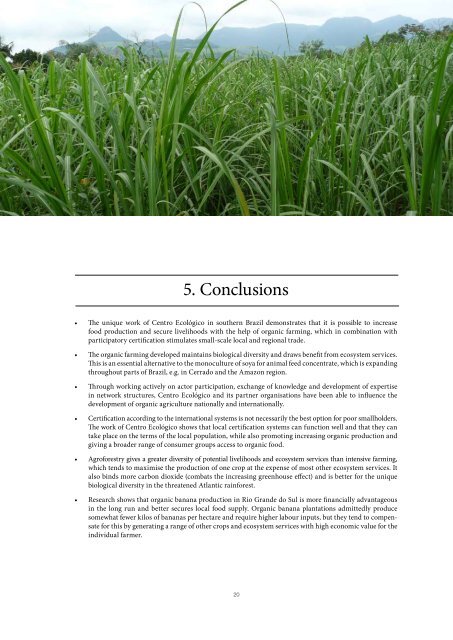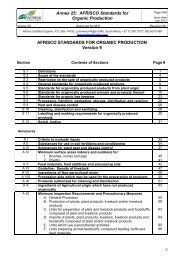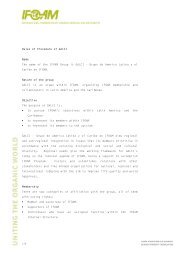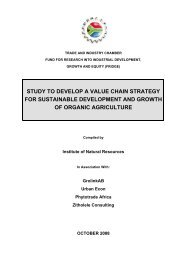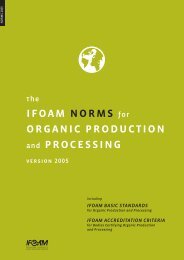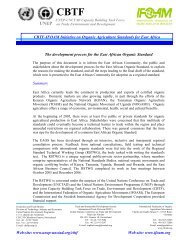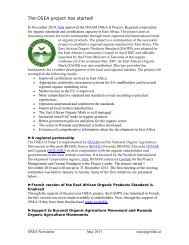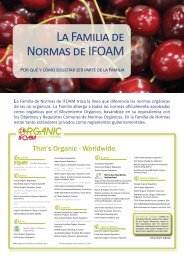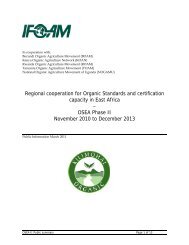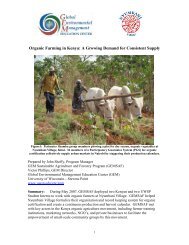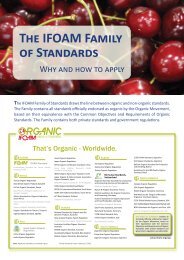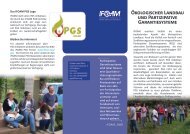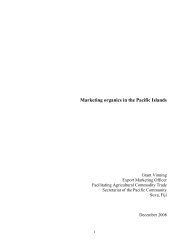Organic farming in Brazil - ifoam
Organic farming in Brazil - ifoam
Organic farming in Brazil - ifoam
Create successful ePaper yourself
Turn your PDF publications into a flip-book with our unique Google optimized e-Paper software.
5. Conclusions<br />
• The unique work of Centro Ecológico <strong>in</strong> southern <strong>Brazil</strong> demonstrates that it is possible to <strong>in</strong>crease<br />
food production and secure livelihoods with the help of organic <strong>farm<strong>in</strong>g</strong>, which <strong>in</strong> comb<strong>in</strong>ation with<br />
participatory certification stimulates small-scale local and regional trade.<br />
• The organic <strong>farm<strong>in</strong>g</strong> developed ma<strong>in</strong>ta<strong>in</strong>s biological diversity and draws benefit from ecosystem services.<br />
This is an essential alternative to the monoculture of soya for animal feed concentrate, which is expand<strong>in</strong>g<br />
throughout parts of <strong>Brazil</strong>, e.g. <strong>in</strong> Cerrado and the Amazon region.<br />
• Through work<strong>in</strong>g actively on actor participation, exchange of knowledge and development of expertise<br />
<strong>in</strong> network structures, Centro Ecológico and its partner organisations have been able to <strong>in</strong>fluence the<br />
development of organic agriculture nationally and <strong>in</strong>ternationally.<br />
• Certification accord<strong>in</strong>g to the <strong>in</strong>ternational systems is not necessarily the best option for poor smallholders.<br />
The work of Centro Ecológico shows that local certification systems can function well and that they can<br />
take place on the terms of the local population, while also promot<strong>in</strong>g <strong>in</strong>creas<strong>in</strong>g organic production and<br />
giv<strong>in</strong>g a broader range of consumer groups access to organic food.<br />
• Agroforestry gives a greater diversity of potential livelihoods and ecosystem services than <strong>in</strong>tensive <strong>farm<strong>in</strong>g</strong>,<br />
which tends to maximise the production of one crop at the expense of most other ecosystem services. It<br />
also b<strong>in</strong>ds more carbon dioxide (combats the <strong>in</strong>creas<strong>in</strong>g greenhouse effect) and is better for the unique<br />
biological diversity <strong>in</strong> the threatened Atlantic ra<strong>in</strong>forest.<br />
• Research shows that organic banana production <strong>in</strong> Rio Grande do Sul is more f<strong>in</strong>ancially advantageous<br />
<strong>in</strong> the long run and better secures local food supply. <strong>Organic</strong> banana plantations admittedly produce<br />
somewhat fewer kilos of bananas per hectare and require higher labour <strong>in</strong>puts, but they tend to compensate<br />
for this by generat<strong>in</strong>g a range of other crops and ecosystem services with high economic value for the<br />
<strong>in</strong>dividual farmer.<br />
20


